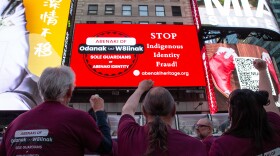Since the 1900s, the country's most iconic bridges and skyscrapers have been put up by men who risked life and limb to connect steel beams hundreds of feet in the sky. Ironworkers come from all backgrounds, but a small Indian reserve outside Montreal has supplied the U.S. with a proud lineage of Mohawk ironworkers.

But with fewer Mohawks going into the trade, the tradition may be on the wane.
Striding across a steel beam 26 stories in the sky, a lean ironworker grabs the corner column and pulls himself up. What could someday be a corner office on 55th Street in Manhattan is now nothing but open air. It's windless and the sun is bright, a perfect day for putting up steel.
"Like Houdini, he gets up there and disappears," one of the workers says of Kaniehtakeron Martin. "Poof!"
In 2 1/2 hours, the crew lays 68 pieces of steel.
"I'm a connector in the raising gang. It's my job to climb the steel and erect the iron," says Martin, or Geggs as he's known. "It's my job to put the building up, basically. The only thing mechanized about it is the crane."
Martin is a fourth-generation Mohawk ironworker from a reserve just south of Montreal. At about 5 feet 8 inches, the 35-year-old is one of the smaller guys on the site, and with 15 years of experience, one of the smartest.
"A lot of people, they watch us, they see what we do and they ask me if I'm crazy, but it's fun. You gotta love what you do," he says. "They always often ask me, 'Are you afraid of heights?' Naw, I'm not. A lot of people are, but I'm one of them who isn't."
The Long Commute
At the peak in the 1950s, there were as many as 800 Mohawks living in New York City. Now, Martin is one of about 200.
Historians have several explanations of how Mohawks ended up on high steel. Some say they've honed their balance and strength with a history of hunting, fur trading and later driving logs. But the reason the trade endures is probably more practical: It pays really well. Martin makes more than $100 an hour, and the benefits are good.
During the workweek, he lives in a small four-story walkup in Brooklyn. An uncle and nine other ironworkers from his reserve in Kahnawake stay here during the week.
"We'll get home, try to cram in a week's worth of being a dad in two days and a husband, and Sunday we're off back to work on the road again," he says.
At work's end on Friday, they pair off and drive the 6 1/2 hours home. But rain can slow construction and on a recent weekend, Martin was left behind, earning time and a half, but missing his wife and two kids.
A Taste Of Steel
From Kahnawake, you can see the domes of Montreal's churches across the St. Lawrence River. Kids zoom around on ATVs, and the stop signs are in English and Mohawk. There are also reminders of a century-long tradition of ironworking. In the middle of town, sticking straight out of the ground about 30 feet into the sky, are two steel beams.
Joe Delaronde, who works at a local radio station next to the beams, says they were used for competitions.
"Young guys, especially who've never done ironwork, it gives them a taste of what it feels like to go up a steel beam 'cause that's a real steel beam," he says.
They're not used much anymore, he says, but kids aren't prevented from clambering up, either.
"The guys would go up and see how quickly they could attach some of the pieces of iron together and ring a bell, come back down and whoever would be the quickest one would win," he says. "If you were a real ironworker and some guy that never did it beat you, you'd look pretty bad, so it was intense."
In Their Genes
Mike Delisle, the grand chief of Kahnawake, also comes from a family of ironworkers and did some himself before returning to the reserve. He keeps blueprints of the World Trade Center in his basement. His father's wrenches hang on the walls.
Young people are taking more jobs in the thriving tobacco industry on the reserve rather than apprentice as ironworkers, he says. Each year, there are about 10 new Mohawk ironworkers out of the 100 new recruits at New York's local.
"I would hope that more of our young men — and women, if they choose to; [it's] a very hard trade — would go back to it and become more integrated into it, because I think we've lost some of that work ethic over the past two if not three decades."
It is hard work. Martin blew out his right knee a year and a half ago, and he's been favoring the left, which is getting sore now. His wife, Cheryl Zachary, says her 10-year-old son, a hockey fanatic like his dad, is already pining to join his father's trade.
"Actually, he says often that he wants to be an ironworker," she says. "I told him he wasn't allowed to leave me, but if he really wants to do it, I would support him."
In Kahnawake, they say ironwork built the town, and most hope it will continue to do so for years to come.
Copyright 2012 WNYC Radio














